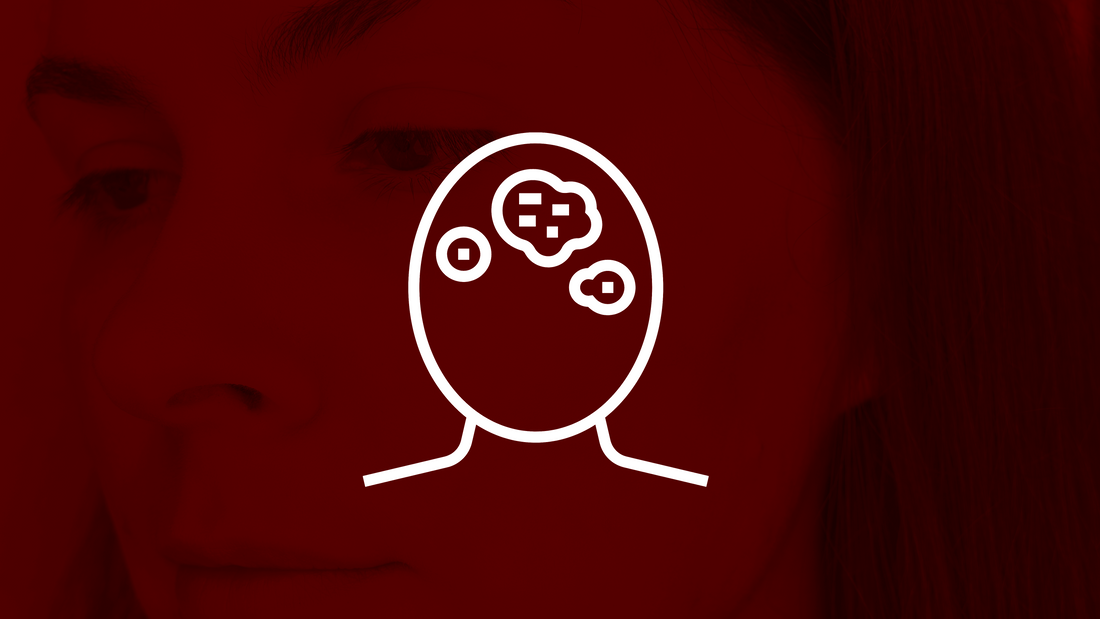Rosacea is a chronic inflammatory skin condition that requires attention and care to keep in check. If you have rosacea, you know how persistent the symptoms can be.
From topical treatments to oral antibiotics to behavioral tips, it can be hard to find a path that works consistently.

However, red light therapy (RLT) has emerged as a promising treatment for this dermatological disease.
RLT supports the body with an inside-out approach. This reduces inflammation and redness while also treating symptoms.
In the following sections, we discuss how RLT treats rosacea, reasonable expectations for results of regular treatment, and how to use red light therapy for optimal results. We also include some other great habit-based tips that may help reduce inflammation.
Take a look at red light therapy panels to find safe treatment.

The Symptoms of Rosacea

Rosacea is a chronic inflammatory skin disorder that manifests primarily on the face. Clinical trials show that an estimated 14 million people in the US have some form of rosacea.
Rosacea is a genetic condition and is more prevalent among lighter-skinned individuals.
It is sometimes misdiagnosed as eczema, an allergy, or acne, so the disorder could affect more than have been officially diagnosed.
The causes of rosacea are not fully understood, and no permanent cure has been discovered yet.
But, this doesn't mean there isn't still hope!
There are many sets of behavioral habits and treatments that can help relieve symptoms while helping to reduce psychological distress and flare-ups.
Depression, anxiety, loss of self-esteem, and social phobias are common emotional effects of rosacea. Many patients suffer from social stigmas.
This is partly because we're eager to share with you some treatments that help manage rosacea. We'll start with some of the basics, which have more to do with habits and behavior.
Then, we'll discuss some of the more advanced treatments that have changed people's lives.
Treatments for Rosacea
Treating rosacea requires a focus on alleviating symptoms, usually by using a combination of enhanced skin care practices and prescription medications.
However, since none of these methods present a cure, recurrence of symptoms is frustratingly common and may vary depending on one's rosacea subtype.

Good self-care practices help treat rosacea. Methods include:
- Identifying environmental factors and dietary triggers
- Sun protection, using a UVA/UVB blocking broad-spectrum sunscreen
- Protecting one's face in cold weather
- Using mild cleansers and natural moisturizers
Many patients also use makeup to reduce the appearance of redness, but this must be done with caution as allergic or other skin reactions may occur.
Alternative medicine such as facial massages, moderate caffeine intake (iced, not hot), and meditation can also be effective because they help alleviate stress, which can worsen symptoms and flare-ups. Emu oil and oregano oil have also been touted as ways to treat rosacea and facial redness, but their efficacy is not confirmed.

Topical prescription drugs can help by constricting blood vessels, which reduces redness and provides relatively fast, but temporary, results.
Additionally, bumps and pimples can be managed through the use of prescription oral antibiotics and acne medications.
Overall though, none of these treatments are reliably effective for all individuals, and when they work, they’re not particularly long-lasting.
In the absence of a cure and with the ongoing expense of over-the-counter drugs, creams, and ointments for facial redness, many are in search of alternative solutions.
If you, a friend, or a family member is experiencing a similar struggle, red light therapy may be worth a look.
Light Treatments for Rosacea
LED therapy for rosacea is available with a range of options, including laser resurfacing, yellow, green, blue, or red varieties. Each type of led therapy has a slightly different application, but overall they can be used to remove skin thickening, reduce redness, and ease discomfort.
Unlike most rosacea treatments on the market today, red light therapy is not a superficial remedy that addresses only symptoms. Rather, red light treats the root of the problem.
While it is not a total cure for rosacea, advanced red light treatment increases energy production in cells and reduces inflammation.
It's an inside-out approach to restoring healthy skin.
Red Light Treatment for Rosacea: Before and After
Is red light therapy effective at treating rosacea?
Of course, seeing real results can be far more compelling than reading reviews.
To date, the only study on the effects of red light on rosacea used a combination of blue and red wavelengths to address visible blood vessels and skin thickening. This small preliminary study treated just two individuals: a 22-year-old Caucasian woman and a 68-year-old Caucasian male.
As you can see from the images, the results after 10 treatment sessions are dramatic.

Papulopustular rosacea on the nose of case report 1 at the base time (a), after five sessions (b), and after ten sessions (c) with coupled blue (489 nm) and red (650 nm) light emitting diodes therapy.

Papulopustular rosacea with erythema and telangiectasias on the glabella, forehead, nose, cheeks, and chin of case report 2 at the base time (a), after five sessions (b), and after ten sessions (c) with couples blue (480 nm) and red (650 nm) light-emitting diodes therapy.
Laser Resurfacing
Although it's seldom covered by health insurance, laser treatment helps reduce rosacea symptoms:
Erbium YAG lasers target visible blood vessels and remove excess tissue to reshape bulbous noses with about a 50 percent reduction in symptoms.
CO2 lasers (ablative lasers) are used to reshape the nose or other parts of the face that have been scarred by inflamed tissue, with significant improvement in the erythema (swelling) and other secondary symptoms of rosacea.
Pulsed-dye lasers penetrate vascular lesions (visible blood vessels). Dyes used minimize the red, inflamed appearance through intense pulsed light, treating ocular rosacea.

Laser resurfacing can treat two major rosacea symptoms: visible blood vessels, and thickened skin.
Skin thickening is especially common around the nose when the condition is left untreated, resulting in a condition referred to as phymatous rosacea. But buildup can happen anywhere, along with blood vessels appearing in affected areas.
The most common side effect of laser therapy for rosacea patients is increased redness, which usually fades within one to two weeks. Other temporary side effects may include rashes, itching, and tight skin. In rare cases, laser therapy can cause burning.
The downside is that taser resurfacing isn't cheap.
Laser treatment usually costs from $500 to $700 per session, out of pocket.
Several sessions are needed depending on the severity of the condition. When used to diminish the appearance of visible blood vessels, the results of laser therapy last about three to five years. While treated blood vessels won’t reappear, new ones can form.
Medication and follow-up laser therapy may be needed.
Red Light Therapy for Rosacea
Red light therapy is a more affordable way to treat red rosacea. This involves exposing the skin to strong sources of visible red light (610-700nm), typically through hi-tech, LED bulbs
Red light therapy is not a permanent cure for rosacea.
However, it does help reduce general skin redness and promotes healthy cellular functioning.
Every color of light corresponds to a different wavelength, but red light therapy appears to be the only wavelength band that can help treat rosacea.

All other wavelengths—including amber, green, and blue light—only penetrate the skin at the very surface level. This makes them great for acne, mild wrinkles, and other minor skin blemishes.
Red light penetrates below the surface of the skin, and stimulates improved cellular function. This makes it effective at treating a variety of skin conditions, and as a bonus, there are no known side effects. Generally, a mixture of light treatments may garner optimal results, depending on the condition and its severity.
The Benefits of Red Light Therapy include:
- Stimulating scalp hair growth
- Treating psoriasis and eczema
- Toning aging skin by stimulating the production of collagen for improved skin elasticity, and a youthful appearance
- Reducing acne breakouts and inflammation, including acne vulgaris.
- Reduction of fine lines, sagging skin, sun damage, wrinkles, and age spots
- Accelerated skin wound healing
- Healing of non-melanoma skin cancers
Let’s take a closer look at how red light therapy works.
How Red Light Therapy Works
Red light is bioactive in humans. In the same way that plants convert absorbed sunlight into energy, the human body converts absorbed red light into cellular fuel.
Red light penetrates deep into the skin to a depth of about 8-10mm, where it stimulates the production of adenosine triphosphate (ATP) in the cells’ mitochondria. ATP is the primary energy source for cells, operating at the ideal wavelengths to heal the skin.

Above: Increased ATP production provides a variety of benefits, including improved collagen production and better nerve cell health.
Restored cellular energy quickly leads to cellular health. An optimally fueled cell has the resources to perform its functions at a high level, including accelerated healing and regeneration.
Treatment consists of several minutes of exposure to high-intensity LED lights.
During treatment, the red light penetrates the skin and performs several important functions:
- Treating rosacea increases the production of ATP
- Increases the production of collagen (collagen stimulation yields better results than resurfacing the outer layers of the skin)
- Increases formation of new capillaries that deliver oxygen and nutrients to the skin
- And stimulates the lymphatic system, which helps the body remove waste and toxins
Within a short time, red light therapy may ease flushing, burning, swelling, tenderness, and bumps. It may also stimulate the repair of broken capillaries on the cheeks and nose.
So again, while there haven’t been any studies directly examining the connection between rosacea and red light therapy, it is known to treat a variety of similar symptoms.
Red Light Therapy for at-Home Rosacea Treatment
Today, high-quality LED light panels are available for home use, which makes the treatment of rosacea much more convenient. Using red light therapy for rosacea is also far less costly than seeing a dermatologist
Results require short, but frequent treatments.
LED light should be used with caution. It does generate some heat, and rosacea is sensitive to heat, but everyone’s threshold is different.
If you are taking topical medication for rosacea, please consult your doctor about using red light as some topical medicines make the skin more photosensitive and prone to burning.

How quickly you experience results depends on your skin’s sensitivity to red light, the severity of your symptoms, and your commitment to consistent treatment.
You may experience immediate relief of itching, redness, inflammation, and pain. If you have a severe case of rosacea, your results may come more slowly as the skin heals from within. Also, some people are sensitive to LED light therapy and experience temporary redness which normally subsides quickly.
Does Red Light Therapy Help Treat Rosacea?
Red light therapy is a natural, non-invasive, and pain-free treatment for common skin problems including acne, eczema, and psoriasis.
Because it promotes healing at the cellular level, it's photobiological effects may be beneficial for treating this sometimes embarrassing and often uncomfortable skin condition.
If you’d like to learn more about its many applications, take a look at some of our red light therapy solutions in our BIOMAX Series, and please contact us if we can help answer any questions about how red light therapy can help improve your symptoms.
Meanwhile, the SaunaMAX Pro has all the features of the BIOMAX Series, but can be used for in-sauna treatment. It's the ideal panel for red light therapy users who also have a home sauna.



